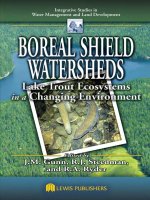Lake Trout Ecosystems in a Changing Environment - Chapter 2 doc
Bạn đang xem bản rút gọn của tài liệu. Xem và tải ngay bản đầy đủ của tài liệu tại đây (274.59 KB, 15 trang )
© 2004 by CRC Press LLC
chapter two
History and evolution of lake trout
in Shield lakes: past and future
challenges
Chris C. Wilson
Ontario Ministry of Natural Resources
Nicholas E. Mandrak
Department of Fisheries and Oceans
Contents
Introduction
Evolutionary history
Glacial refugia and historical genetics: peering into the past
Postglacial dispersal
Secondary contact among refugial groups
Genetic structure of modern populations
Species interactions and anthropogenic disturbances
Research needs
Conclusion
References
Introduction
Evidence suggests that lake trout likely evolved in response to environmental changes
caused by glaciation events during the Pleistocene era. Following the retreat of the last
ice sheets, lake trout recolonized their present range from multiple refugia. Populations
in Boreal Shield lakes are descended from at least six refugial groups, with the greatest
contributions from Mississippian and Atlantic sources. Secondary contact among these
separate lineages was a significant source of genetic diversity, enabling adaptation to local
environments.
Suprisingly little is known about the diversity and adaptive structure of inland lake
trout populations. There is some evidence of local adaptation among inland populations
and stocking strains as well as differential fitness between native and stocked lake trout.
© 2004 by CRC Press LLC
However, many issues regarding lake trout adaptation and fitness remain unresolved. In
addition, the biological characteristics of lake trout make them extremely vulnerable to
natural and anthropogenic disturbances, which present significant management chal
-
lenges to ensure their persistence.
Lake trout have often been described as a “glacial relict,” a holdover from the Ice Age
that lives primarily in deep, cold-water habitats. The species has certainly been intimately
associated with glacial events and is perhaps better adapted to the past than the present.
The fascination of anglers and biologists with lake trout may in part stem from the
prehistoric mystique of this giant, primitive-appearing freshwater salmonid. In fact, how
-
ever, lake trout are anything but ancient and primitive, having evolved no more than 3
million years ago and being specialized for habitats that did not exist before the Pleistocene
glaciations.
Based on morphologic systematic and genetic data, lake trout are thought to have
diverged from other species of Salvelinus approximately 1 to 3 million years ago (Behnke,
1972; Grewe et
al., 1990; Phillips et al., 1992), roughly coincident with the onset of the
Pleistocene glaciations (Dawson, 1992). Lake trout have the most extensive freshwater
distribution of any salmonine: the species’ natural distribution closely matches the North
American limits of the recent (Wisconsinan) glaciation (Lindsey, 1964), where it is largely
restricted to lakes carved out by glacial scouring. Lake trout also differ from all other
members of the genus by lacking the ability to live in salt water, suggesting their evolution
in a purely freshwater environment. Taken together, these facts suggest that the species
evolved in response to altered habitat and ecological conditions caused by Pleistocene
glacial events.
The purpose of this chapter is to describe the historical influences that underpin the
evolutionary biology of lake trout populations in small lakes on the southern Canadian
Shield. Beginning with the historical origins of lake trout (when they first appeared and
where they came from), and postglacial history (how they arrived where they are today),
we examine the influence of these events on modern populations. As well as reconstructing
past events that influenced the current structure and diversity of lake trout, this chapter
attempts to summarize both what is known and what needs to be learned about the present
biology and potential future of these populations. As well as developing some suggested
research themes, some recommendations for sustainable management are presented.
Evolutionary history
The early details of lake trout evolution will likely remain unknown. The close relationship
between lake trout distribution and formerly glaciated areas (Lindsey, 1964; Scott and
Crossman, 1973) suggests that fossil remains preceding the Wisconsinan glaciation were
destroyed long ago by advancing glaciers. However, the roughly coincident divergences
of the three subgenera of Salvelinus (Salvelinus, Cristivomer, and Baione) approximately 2
to 3 million years ago (Behnke, 1972, 1980; Grewe et
al., 1990; Phillips et al., 1992) indicate
a short burst of evolutionary diversification and selection, potentially in response to major
environmental or biotic pressures. The placement of lake trout in its own subgenus (Cris
-
tivomer) indicates the extent of its divergence from other charr species in response to
Pleistocene events (Behnke, 1972).
The nature of glacial disturbances makes it impossible to reconstruct the complete
Pleistocene history of lake trout. Each glaciation effectively bulldozed continental land
-
scapes under a wall of ice, wiping clean the geologic and biologic traces of preceding
events. Because of this, the exact number of Pleistocene glaciations in North America is
uncertain, with estimates ranging between 4 and 20 cycles (Pielou, 1991; Dawson, 1992;
Gunn and Pitblado, Chapter 1, this volume). Each of these undoubtedly had major impacts
© 2004 by CRC Press LLC
on the distribution and genetic structure of lake trout, based on the species’ present
distribution in relation to glacial coverage (Figure
2.1). During each glacial interval, fish
populations were extirpated or displaced, in some cases by thousands of kilometers. Those
fish that survived were limited to a handful of refugial habitats along the periphery of
the ice sheets.
Four main southern and one northern Wisconsinan refugia have been hypothesized
(Bailey and Smith, 1981; Crossman and McAllister, 1986; Figure
2.1). The Atlantic Coastal
refugium existed along the coastal plain east of the Appalachians, south of present-day
Long Island. Smaller Atlantic Coastal Uplands and Grand Banks refugia were also present
along the east coast of North America (Schmidt, 1986). The Mississippi basin, south of the
ice sheets, was the largest Wisconsinan refugium and was separated from the Missourian
refugium by a lobe of ice. Several small refugia (e.g., Nahanni, Banff-Jasper, Waterton)
also existed between the Cordilleran and Laurentide ice sheets (Crossman and McAllister,
1986; Lindsey and McPhail, 1986). The Pacific Coastal (or Cascadia) refugium existed along
the coastal plain west of the Rockies, south of present-day Vancouver Island. Part of
present-day Alaska and land now covered by the Bering Sea formed the Beringian ref
-
ugium in northwestern North America (Figure 1.1).
Very little is known about the habitat or ecological conditions in these peripheral
glacial refuges, including their exact locations. On a local scale, ice movements and shifting
glacial margins would have changed the locations of meltwater impoundments. The
weight of the ice sheets depressed the landscape, so that water draining downhill would
have been dammed by the glaciers themselves (Pielou, 1991). These periglacial aquatic
habitats, which were both dammed and fed by the ice sheets, have no parallel today.
Pielou (1991) gives an excellent description of ice-dammed lakes to the south of the
glaciers, with icebergs and deep, cold water next to the ice walls, gradually becoming
Figure 2.1 Present-day distribution of lake trout, Salvelinus namaycush, in relation to geographic
coverage of glacial ice at the maximum of the Wisconsinan glaciation, approximately 23,000 years
ago. Recognized glacial refugia for northern fishes are shown along the glacial margins (Atl =
Atlantic; Ber = Beringia; Cas = Cascadia; Miss = Mississippi; Mso = Missouri). Glacial coverage
taken from Dyke and Prest (1987b); lake trout distribution from Lee et
al. (1980); glacial refugia from
Crossman and McAllister (1986).
© 2004 by CRC Press LLC
shallower to the south. These proglacial lakes probably stratified in summer, and received
a variety of substrates from rock flour to boulders from the ice and meltwater. As a result,
these lakes may have contained a variety of habitats that supported diverse aquatic
communities. Although lake trout probably thrived under these conditions, they were
nonetheless confined to a small number of fringe habitats or regional metapopulations
for tens of thousands of years during each glaciation (Bailey and Smith, 1981).
As the glaciers retreated at the end of each glacial cycle, huge volumes of meltwater
were released, creating giant lakes that dwarfed any lake that exists today. These lakes
were only temporary, however, and constantly changed their size, shape, and location in
response to the retreating ice (Dyke and Prest, 1987b). As the glaciers receded and the
newly exposed landscape rose up through isostatic rebound, the lakes followed the
retreating glacial margins. Further retreat uncovered progressively lower drainage out
-
lets, often causing dramatic drainage events and emptying or connection of water bodies
(Mandrak and Crossman, 1992). The size, mobility, and interconnectedness of these
proglacial lakes provided unprecedented opportunities for dispersal and colonization of
the newly exposed landscape. These postglacial drainage events permitted movement of
lake trout over hundreds and perhaps thousands of kilometers, potentially within a single
generation.
Ecological conditions within the proglacial lakes changed considerably over time
and may have varied significantly within each lake as well. For example, the Champlain
Sea ⎯ a marine incursion of the St. Lawrence Lowlands between 11,800 and 8800 years
ago ⎯ underwent dramatic ecological change, going from a fresh, meltwater lake (glacial
Lake Vermont) to an inland sea to fresh again (Lampsilis Lake) in just a few thousand
years (Dyke and Prest, 1987a; Pielou, 1991). There is also some evidence for spatial
variation in habitat conditions within the major lakes, which is not surprising considering
their enormous sizes. Thermal gradients, glacial till, and varying depth as a result of
crustal deformation may have effectively segregated species within these lakes based on
their ecological requirements.
The huge volumes of cold-water habitat and diverse prey community would have
been ideal for lake trout, and it may be assumed that lake trout populations expanded
rapidly in these proglacial habitats. As the glaciers continued to retreat northward, new
drainage outlets were exposed, which enabled the meltwater lakes to drain over newly
deglaciated terrain. This provided new connections and colonization opportunities among
the proglacial lakes but also decreased the remaining habitat volume. As the volume of
meltwater declined with continued glacial retreat, the proglacial lakes gradually disap
-
peared, leaving most of the modern drainage systems in place by about 5000 to 6000 years
ago (Dyke and Prest, 1987a).
Most of the present lake trout lakes on the Shield began as basins excavated by the
glaciers. Many of these depressions were covered by glacial lakes, which facilitated
extensive colonization. Other basins that were isolated from the large glacial lakes pro
-
vided reduced opportunities for colonization. As a result, the timing and extent of colo-
nization were highly variable and strongly influenced by lake elevation, distance from
source pools (proglacial lakes), and type of access (lake source, outlet, postglacial con
-
nections) (Mandrak, 1995). As a result of their different origins and histories, lakes on the
Shield were isolated for varying lengths of time, with considerably variable colonization
opportunities. Lakes covered by proglacial meltwaters were likely colonized by more
species and by greater numbers within species than uncovered lakes, leading to variation
in the composition and size of the founding gene pools and assemblages. Conversely,
areas that were not covered by the meltwater lakes had reduced colonization opportuni
-
ties, which led to lower species diversity, smaller founding numbers, and reduced biodi-
versity at community, population, and genetic levels. As water levels dropped and
© 2004 by CRC Press LLC
colonization opportunities ended, the immigrant populations and assemblages were
forced to adapt to local abiotic and biotic conditions in the diverse mosaic of smaller
inland lakes that exists today.
Glacial refugia and historical genetics: peering into the past
The number and locations of refugia used by lake trout during the last (Wisconsinan)
glacial event have been debated for half a century. The many, often-conflicting views have
been summarized elsewhere (Martin and Olver, 1980; Crossman and McAllister, 1986;
Wilson and Hebert, 1996, 1998) and need not be repeated here. The debate over the species’
Quaternary history has largely been resolved by recent genetic evidence, which indicates
that lake trout colonized their modern range from multiple refugia. Ihssen et
al. (1988)
detected two genetic groups of lake trout in Ontario and Manitoba based on allozyme
data, which they interpreted as being Mississippian and Atlantic in origin. In addition,
they inferred a third, distinct source for several lake trout populations in the Haliburton
area of eastern Ontario (Ihssen et
al., 1988). Analysis of mitochondrial DNA (mtDNA)
among eastern hatchery strains similarly revealed three distinct lineages, which were
interpreted as having Atlantic, Mississippian, and Beringian origins (Grewe and Hebert,
1988). Geographic surveys of mtDNA variation among native lake trout populations across
the species’ range confirmed the existence of multiple refugial groups (Wilson and Hebert,
1996, 1998). In addition to the three major lineages identified by Grewe and Hebert (1988),
genetic and geographic substructure within these lineages suggested their dispersal from
multiple glacial refugia (Figure
2.2; Wilson and Hebert, 1996, 1998). Based on the geo-
graphic distribution of the different mtDNA lineages, it appears that lake trout survived
the Wisconsinan glaciation in at least six different refugia: two Beringian, two Mississip
-
pian, one Atlantic, and one in southern Alberta or northern Montana (Wilson and Hebert,
1996, 1998). The postglacial scenario described here largely relies on these latter studies
while also drawing on data from earlier studies and complementary sources (Dyke and
Prest, 1987a,b; Mandrak and Crossman, 1992).
Although much of the species’ genetic history and diversity has undoubtedly been
lost because of prehistoric (Pleistocene) events, the mode and tempo of genetic differen
-
tiation among the different lineages was largely influenced by the timing and extent of
glacial cycles. The mtDNA C lineage mostly likely diverged from other lake trout during
the mid-Pleistocene, at least 600,000 years ago (Figure
2.2; Wilson and Hebert, 1998).
Separation of fish with A mtDNA types from groups B and D probably occurred roughly
300,000 years ago, and the latter two groups diverged during subsequent glaciations
(Wilson and Hebert, 1998). Divergence within the C mtDNA group was probably caused
by the displacement of ancestral populations into separate Beringian, Montana, and Mis
-
sissippian refugia during the Wisconsinan glaciation, where they subsequently diverged
(Wilson and Hebert, 1998). Similar processes within each glacial cycle (population dis
-
placement and subdivision by advancing glaciers, allopatric divergence in separate refu-
gia, and subsequent expansion/recolonization) were probably responsible for much of the
geographic genetic structure that exists among lake trout populations today.
Postglacial dispersal
The major mtDNA lineages show clear differences in their geographic distribution despite
considerable overlap in some regions (Figure
2.3). Populations in Quebec, eastern Ontario,
the maritime provinces, and New England were primarily colonized by lake trout from
an Atlantic refuge, with some Atlantic fish reaching as far west as Lake Superior and Lake
Nipigon. Fish from two Mississippian sources (lineages A and C1) colonized areas south
© 2004 by CRC Press LLC
of the Great Lakes, virtually all of Ontario, parts of Quebec, and northwestward through
central Canada to Great Slave Lake. Lake trout from two separate Beringian refugia
dispersed south and east but primarily contributed to areas west of the Canadian Shield.
For southern Shield lakes, Beringian lake trout contributed to populations in western
Ontario and Quebec as well as the upper Great Lakes. Lake trout from the Montana refuge
also made minor contributions to western Ontario populations, but the Mississippian and
Atlantic refugia were the major contributing sources for establishing populations in most
of the study area (Figure
2.3).
The detailed geologic record left by the glaciers and proglacial lakes has enabled the
reconstruction of postglacial drainage and colonization events (Figure
2.4; see also Man-
drak and Crossman, 1992). Fish communities in the study area were greatly influenced
by the formation of giant proglacial lakes in and near what is now the Great Lakes basin
between 14,500 and 7900 years ago (Dyke and Prest, 1987a; Mandrak and Crossman, 1992).
Lake Agassiz, which lasted for most of this period, covered much of Manitoba and large
portions of Saskatchewan, North Dakota, Minnesota and Ontario during its existence,
providing dispersal and colonization opportunities for many species that were present in
the Mississippian and Missourian refugia (Teller and Clayton, 1983; Mandrak and
Crossman, 1992).
Lake Agassiz drained southward into the Mississippi basin, briefly to the northwest,
then southeastward into the Superior basin, and finally eastward into Lake Barlow-Ojib
-
way (Mandrak and Crossman, 1992). Lake Barlow-Ojibway extended across northeastern
Ontario and northwestern Quebec, and drained into the Ottawa River before abruptly
emptying into James Bay 7900 years ago (Dyke and Prest, 1987b). A series of proglacial
Figure 2.2 Simplified cladogram showing S. namaycush mitochondrial DNA lineages (A–D) detected
by Wilson and Hebert (1996, 1998) and their association with glacial refugia during the most recent
glaciation. Branch lengths are not proportional to genetic divergence among lineages.
A Mississippi
B Atlantic
D Nahanni (Beringia)
C1 Mississippi
C2 Beringia
C3 Montana
© 2004 by CRC Press LLC
and glacial lakes also drained into Lake Agassiz from the west, facilitating immigration
of lake trout from western refugia (Wilson and Hebert, 1998).
The fossil evidence suggests that lake trout were able to closely follow the retreating
glacial margins: the species was present in northern Wisconsin (Hussakof, 1916) 12,500 to
16,000 years ago (Lindsey 1964) and in eastern Ontario approximately 10,000 years ago
(Gruchy, 1968, in Crossman and McAllister, 1986). This close connection among lake trout
movements, glacial retreat, and proglacial lake positions and connections is also supported
by the genetic data (Wilson and Hebert, 1996, 1998). Colonization of the study area by
lake trout with Mississippian and Atlantic origins occurred initially through glacial lakes
in the lower Great Lakes basin, roughly 14,000 to 13,500 years ago (Wilson and Hebert,
1996). Although dispersal from the Atlantic refuge may have been hindered by the Cham
-
plain Sea, eastern lake trout were probably able to effectively colonize southern Shield
lakes by 10,000 years ago (Wilson and Hebert, 1996). A series of proglacial lakes (Lakes
Peace, McConnell, Agassiz, and Barlow-Ojibway) extending from the Yukon southeast
through to Quebec allowed colonization by lake trout with Atlantic, Beringian, Mississip
-
pian, and, to a lesser extent, Montanan affinities (Wilson and Hebert, 1996, 1998;
Figure
2.4). Lake trout from these western refugia did not reach the Canadian Shield until
9500 years ago (Wilson and Hebert, 1996). It is possible that these groups did not make
greater contributions because of early colonization by Mississippian and Atlantic fish
(Wilson and Hebert, 1996, 1998). Early populations would have expanded rapidly, creating
a strong priority effect. Alternatively, isolation in separate refugia may have resulted in
differences in fitness among lineages under varying conditions, although this has not been
tested.
Secondary contact among refugial groups
Secondary contact among the different refugial groups occurred throughout the central
portion of the species range, particularly within areas covered by the proglacial lakes
(Figures 2.3 and 2.4). In the principal study area, contact was most extensive between the
Mississippian and Atlantic refugial groups, with both lineages occurring through southern
Quebec and Ontario as well as northern New York State (Wilson and Hebert, 1996).
This extensive contact and interbreeding among refugial groups accounts for some
disagreements or conflicts among earlier studies of lake trout postglacial history. This is
clearly illustrated by previous morphologic analyses: although differences among geo
-
graphic populations were recognized by Lindsey (1964) and quantified by Khan and Qadri
(1971), the extensive contact among refugial groups prevented discrimination of postgla
-
cial history among most populations examined (Crossman and McAllister, 1986). It is also
possible that adaptation to local conditions resulted in morphologic differentiation, further
confounding historical analyses.
Other data sources also show evidence of secondary contact among refugial groups.
The parasitic nematode Cystidicola stigmatura uses lake trout and the opossum shrimp
Mysis relicta as its primary and alternate hosts and occurs in many lake trout populations
in Ontario and southwestern Quebec (Black, 1983). Although originally used to infer
dispersal from a Mississippian refuge (Black, 1983), the distribution of C. stigmatura likely
also reflects colonization events by other lake trout that came into contact with infected
Mississippian-origin hosts. Mixed-origin ancestry of Shield lake trout populations was
also shown by Ihssen et
al. (1988) using allozyme data. Although their data were initially
interpreted as showing the allopatric distribution of lake trout from Atlantic versus Mis
-
sissippian refugia (Ihssen et al., 1988), it actually provides detailed information on the
extent of two contact zones in Ontario. The majority of populations surveyed east of 82ºW
show shared ancestry from Mississippian and Atlantic fish, whereas Atlantic-refuge fish
© 2004 by CRC Press LLC
are largely absent from more western populations (Ihssen et al., 1988). Rather than repre-
senting purely Mississippian fish, however, these western populations resulted from con-
tact of Mississippian lake trout with those from the three western refugia (Figures. 2.3 and
2.4). Ironically, the “glacial relict” populations of lake trout identified by Ihssen et
al. near
Haliburton, Ontario appear to be isolated descendants of Mississippian fish that did not
come into contact with lake trout from other refugia (Wilson and Hebert, 1996), probably
because of the brief time window for colonization as the glaciers retreated (Mandrak and
Crossman, 1992).
Genetic structure of modern populations
Although historical events played a major role in structuring the genetic and phenotypic
diversity of lake trout, populations in southern Shield habitats have been adapting to local
conditions for over a thousand generations and now reflect the joint influence of historical
and ecological factors. The low levels of genetic diversity that have been observed in lake
trout (Ihssen et
al., 1988; Wilson and Hebert, 1996, 1998) are similar to those observed in
other species from northern climes (Bernatchez and Dodson, 1991; Billington and Hebert,
1991; Wilson et
al., 1996; Bernatchez and Wilson, 1998). This is most likely a result of
constrained or bottlenecked refugial populations during glaciations (Avise et
al., 1984). In
addition, it is possible that genetic diversity of lake trout has been further reduced by
demographic constraints on populations such as large-bodied, long-lived top predators
that generally live in low productivity environments.
Levels of diversity within populations are likely constrained by a combination of
historical and ecological factors. For example, lake trout populations that occur within
areas formerly covered by proglacial lakes have relatively high levels of mtDNA diversity
as a result of secondary contact of refugial groups. Conversely, populations outside the
Figure 2.3 Geographic distributions of S. namaycush refugial groups, as evidenced by distribution
of mitochondrial DNA lineages (modified from Wilson and Hebert 1996, 1998).
© 2004 by CRC Press LLC
former lake borders have very low levels of genetic (mtDNA) diversity, which likely reflect
the more restricted opportunities for colonization and smaller sizes of founding popula
-
tions (Wilson and Hebert, 1998).
(a)
(b)
Figure 2.4 Dispersal of lake trout from glacial refugia during the late Pleistocene and Holocene
(18,000 years ago to the present). (a) Recolonization of the species range; (b) timing of colonization
events in the principal study area. Modified from Wilson and Hebert (1996, 1998).
© 2004 by CRC Press LLC
In addition, genetic diversity of populations may be limited by volume of suitable
habitat (lake area vs. diversity) and habitat age (time since deglaciation vs. diversity). This
is largely speculative, although Ihssen et
al. (1988) observed a significant correlation
between lake area and the proportion of allozyme loci that were polymorphic in the
resident lake trout population (p < 0.01). Larger lakes in their survey also had more alleles
per locus than did small inland lakes, although this may have been partly confounded by
historical (colonization) factors. Ihssen et
al. attributed their findings to population size
effects, as large populations may be expected to contain greater genetic diversity than
smaller populations.
Although many existing populations of lake trout have been in place for less than
10,000 years, there have been ample opportunities for local adaptation to occur. The areas
of secondary contact among the different refugial groups contained huge potential for
selection and local adaptation, as the coming together of lake trout that had been isolated
and exposed to different ecological conditions for tens of thousands of years would have
provided plenty of raw material for natural selection to act on. This would have been
compounded as the different lineages began to interbreed, as their offspring would have
possessed entirely new combinations of genes and adaptive abilities. Recent evidence that
significant evolutionary change can occur in short ecological time spans in some species
(Thompson, 1998) may indicate that selection and adaptation to local environments
occurred within the first few centuries following colonization. This is supported by the
residual genetic structure of lake trout in Lac des Chasseurs, Quebec, where the entire
population carries an mtDNA haplotype that may have provided a selective advantage
in the early stages of population formation (Wilson and Bernatchez, 1998).
There is anecdotal evidence for multiple locally adapted stocks within the Great Lakes,
although many of these disappeared as lake trout stocks declined (Brown, 1981; Goodier
et
al., 1981). For populations in inland lakes, there is less evidence for local adaptation. It
must be emphasized, however, that this lack of evidence reflects the different focus of past
research efforts and the difficulties involved in measuring local adaptation, rather than
the lack of local adaptation itself. Ecological data such as life history, growth rates, and
spawning preferences certainly suggest that inland populations are well adapted to their
particular surroundings (Martin and Olver, 1980). Most evidence of local adaptation is
indirect, such as examples of native populations having higher fitness than stocked lake
trout (described below). One clear example of local specialization was the subspecies
Salvelinus namaycush huronicus, which was described by Hubbs (1929) from Rush Lake in
northern Michigan. This dwarf subspecies or morph coexisted with normal lake trout by
inhabiting deeper waters and living as a benthic feeder (Hubbs, 1929). In addition to being
at most one-quarter the size of the more pelagic regular form, these fish had broader, blunt
heads and large fins (Hubbs and Lagler, 1959). Hubbs (1929) also reported that huronicus
spawned in mid- to late summer, at a depth of about 120 feet. Hubbs was of the opinion
that the two forms did not interbreed and were very distinct ecologically. Sadly, this unique
subspecies is now presumed to be extinct (Hubbs and Lagler, 1959).
There is surprisingly little evidence dealing with adaptive variation of lake trout
populations from small inland lakes despite abundant anecdotal data about individual
populations. Given the diverse history, sources, and length of isolation of many Shield
lakes, however, adaptation to local conditions has most likely led to considerable genotypic
and phenotypic variation among resident populations. Numerous color variants have been
identified in Shield lake trout populations, including black fins (e.g., Redstone Lake) and
pale or dark background coloration (e.g., Lost Dog Lake and Canisbay Lake in Algonquin
Park). One unique population that is both visually and genetically distinct from neigh
-
boring populations is Kingscote Lake in southern Algonquin Park: lake trout native to
© 2004 by CRC Press LLC
this lake lack any spotting pattern and have a uniform silvery-gold body coloration
(C.
Wilson, unpublished data). In general, however, it would be inadvisable to assign too
much importance to color variants because coloration of lake trout may be influenced by
diet (Scott and Crossman, 1973; Martin and Olver, 1980). Greater variability is exhibited
in other morphologic characteristics such as pyloric caecae and head morphology (Martin
and Olver, 1980; P. Ihssen, Ontario Ministry of Natural Resources, unpublished data). It
is likely that lake trout populations exhibit substantial genetic variation at both neutral
marker systems and functional gene loci as the result of their varying histories and
subsequent adaptation. Identifying and assessing the significance of potentially adaptive
genetic diversity both within and among populations is an urgent need for both research
and management.
In contrast to other salmonids, lake trout show very little tendency to diversify into
specialized sympatric morphs or subspecies, although the Rush Lake S. namaycush huroni
-
cus and the siscowet, S. namaycush siscowet, are notable exceptions. Interestingly, mtDNA
from at least four refugial groups has been observed in siscowet, indicating that this morph
has evolved from mixed origins within the last 14,000 years, since the last glacial retreat
(Burnham-Curtis, 1993; Wilson and Hebert, 1996, 1998). As an aside, it is worth noting
that both examples of subspecific differentiation in lake trout come from extremely deep
lakes that may allow for vertical partitioning of predator niches. It may be that what are
generally considered normal conditions for lake trout (cold, low productivity, well-oxy
-
genated lakes) provide stable ecological environments that limit or constrain ecological
diversification and differentiation within the species.
For many years it was thought that lake trout had preprogrammed developmental
tendencies for piscivory or planktivory, and many populations were classified as large-
growing (piscivorous) or small (planktivory). The contrast between lake trout in Lake
Opeongo and those in Lake Louisa in Algonquin Park provided a widely touted example
of this (Martin and Olver, 1980). Recent data, however, indicate that either feed
-
ing/growth type may be expressed by the same population under different circum-
stances. Using stable isotope analysis, Vander Zanden et al. (1999) demonstrated that
formerly piscivorous lake trout populations switched to planktivory after their lakes were
invaded by rock bass.
Although lake trout have been intensively studied for decades, recent studies may
indicate that we do not yet understand its ecological niche. The strong historical focus on
Great Lakes populations has created a perception of lake trout as having narrow ecological
tolerances for ecological factors such as temperature and oxygen levels (e.g., Behnke, 1972).
Work done on lakes in Ontario’s Experimental Lakes Area, however, has demonstrated
that thermal characteristics of utilized habitats can vary considerably among lakes (Sellers
et
al., 1998). Similarly, Snucins and Gunn (1995) have shown that lake trout may have
adaptive behavioral mechanisms and thermal tolerances that do not fall within stereotypic
confines. An intriguing possibility is that Great Lakes and inland lake trout have become
qualitatively different organisms over the past 10,000 years as a result of divergent selective
and evolutionary trajectories despite their recent (in evolutionary time) shared history. If
so, a great deal of what we think we understand about lake trout biology may need to be
revisited. It may also be that the historical niche of lake trout in inland lakes was broader
than we now recognize but that most “unusual” populations such as those described
above disappeared soon after human colonization because of exploitation and eutrophi
-
cation. Models that attempt to describe the niche and ecological characteristics of lake
trout, such as Ryan and Marshall (1994) and Shuter et
al. (1998), should broaden our
understanding and provide greater appreciation for the species’ adaptive abilities.
© 2004 by CRC Press LLC
Species interactions and anthropogenic disturbances
The close relationship between the distribution and biology of lake trout and Pleistocene
glacial events highlights the interplay between historical and ecological processes in struc
-
turing modern populations. It should be noted that many communities or species assem-
blages in formerly glaciated areas are not in equilibrium in terms of species composition
(Mandrak, 1995). Instead, many of these communities represent subsets of the species
assemblages that were present just before the drainage or disappearance of the giant
proglacial lakes. As communities became constrained to smaller and more restrictive
environments, ecological suitability to the available habitats and interactions between
species have resulted in the species assemblages now present.
Perhaps the best known set of species associations for lake trout is the deepwater
“glaciomarine relict” community (deepwater sculpin, Mysis relicta, and several other inver
-
tebrate species) (Dadswell, 1974). More recently, Evans and Olver (1995), in an analysis of
lake trout introductions among 183 inland populations, found that resident fish commu
-
nities had a significant effect on the success or failure of introductions. Examination of
the Ontario Ministry of Natural Resources Lake Inventory database has also suggested
the possibility of both positive and negative associations between lake trout and a sur
-
prising number of species (N. Mandrak, unpublished data). Many of these potential
relationships, however, have yet to be experimentally or critically examined. Recent alarm
-
ing data from rock bass range expansions indicate that lake trout can be quite sensitive
to community perturbations (Vander Zanden et
al., 1999; J. Casselman, Ontario Ministry
of Natural Resources, personal communication). In addition, data from recovering acidi
-
fied lakes suggest that differential species response to recovery may prevent or deter lake
trout from reassuming their role as dominant top predator (Mills et
al., 2000). Resolving
the biologic relationships between inland lake trout and co-occurring species continues to
be a significant research and management need.
The geographic and genetic structures of existing lake trout populations have been
strongly influenced by historical and ongoing human activities. Past activities such as
overexploitation, habitat degradation, stocking, and transplants have undoubtedly had
major impacts on the structure and fitness of native populations (OMNR, 1991). Although
such activities sometimes resulted in short-term socioeconomic gains, they also regularly
incurred significant long-term ecological and economic costs such as habitat rehabilitation,
population reestablishment and restoration, and long-term stocking programs to compen
-
sate for the absence of naturally reproducing native fish. Given the lake trout’s ecological
characteristics (top predator, long generation time, restrictive habitat requirements, etc.),
we strongly recommend that the species be managed as conservatively as possible.
Of the major impacts that humans have had on lake trout populations (overexploita-
tion, habitat loss/degradation, species introductions, and stocking), stocking has perhaps
had the most insidious effect. Although each of the other factors has long been known to
cause populations to disappear, stocking has only recently been recognized as having the
potential to do the same (Evans and Willox, 1991). The luxury of having native populations
with no stocking history is becoming scarce, and realistic management decisions must be
made in a complex multiuser environment (Waples, 1991). Stocking has and will continue
to be a potent management tool for a variety of purposes (Powell and Carl, this volume).
For the dwindling number of native lake trout populations on the Shield, however, it
carries considerable genetic risks, particularly in small lakes where the native population
may have been progressively fine-tuned to local conditions over literally hundreds or
thousands of generations. It is also worth noting that these same populations may be less
adaptable than when they were first founded, as they no longer have a massive gene pool
(mixed-origin founding population) from which to begin.
© 2004 by CRC Press LLC
Research needs
Many important questions remain to be addressed, such as potential fitness differences
between populations and/or ecotypes under different conditions. Some particular knowl
-
edge gaps that need to be filled are to:
• Characterize the genetic structure and diversity of Boreal Shield populations to
assess effective population sizes and historical demographics from lakes of differ
-
ent sizes and ecological attributes
• Build a “genetic map” of lake trout populations in high-use areas to identify native,
mixed, and hatchery populations in order to establish mixed-use management
plans that balance conservation with resource use
• Assess the adaptive potential of populations from different histories and habitat
sizes in terms of plasticity in life history traits, growth and maturation rates,
thermal tolerance, etc.
• Assess the effects of exploitation and/or other anthropogenic stressors on long-
term diversity and viability of inland lake trout populations
Conclusion
The long-term sustainability of wild lake trout populations requires that we conserve not
only enough fish to catch but enough that populations can continue to evolve and adapt
to future climatic and ecological conditions. The preservation of resident biodiversity is
essential for ensuring the long-term viability of populations as well as maintaining their
heritage value. This is particularly important for deepwater species such as lake trout,
where isolated Shield populations are unlikely to be rescued or rejuvenated by immigra
-
tion from other lake populations (Meffe, 1995). Given the species’ ecological vulnerability,
lake trout management must be governed from the perspective of resource health rather
than being harvest-oriented. With changing times, this has largely been achieved in most
of the jurisdictions within the Boreal Shield, but continuing angler demands, species
invasions, and decreasing habitat quality and quantity will continue to make this a sig
-
nificant challenge.
References
Avise, J.C., Neigel, J.E., and Arnold, J., 1984, Demographic influences on mitochondrial DNA lineage
survivorship in animal populations, Journal of Molecular Evolution 20: 99–105.
Bailey, R.M. and G.R. Smith, 1981. Origin and geography of the fish fauna of the Laurentian Great
Lakes. Canadian Journal of Fisheries and Aquatic Sciences 38: 1539–1561.
Behnke, R.J., 1972, The systematics of salmonid fishes of recently glaciated lakes, Journal of the
Fisheries Research Board of Canada 29: 639–671.
Behnke, R.J., 1980, A systematic review of the genus Salvelinus. In Charrs: Salmonid Fishes of the Genus
Salvelinus, edited by E.K. Balon, Dr.W. Junk, The Hague, pp. 441–480.
Bernatchez, L. and Dodson, J.J., 1991, Phylogeographic structure in mitochondrial DNA of the lake
whitefish (Coregonus clupeaformis) and its relation to Pleistocene glaciations, Evolution 45:
1016–1035.
Bernatchez, L. and Wilson, C.C., 1998, Comparative phylogeography of Nearctic and Palearctic
fishes, Molecular Ecology 7: 431–452.
Billington, N. and Hebert, P.D.N., 1991, Mitochondrial DNA diversity in fishes and its implications
for introductions, Canadian Journal of Fisheries and Aquatic Sciences Suppl. 1: 80–94.
Black, G.A., 1983, Origin, distribution, and postglacial dispersal of a swimbladder nematode,
Cystidicola stigmatura, Canadian Journal of Fisheries and Aquatic Sciences 40: 1244–1253.
© 2004 by CRC Press LLC
Burnham-Curtis, M.K., 1993, Intralacustrine speciation of Salvelinus namaycush in Lake Superior: an
investigation of genetic and morphological variation and evolution of lake trout in the
Laurentian Great Lakes, Ph.D. dissertation, University of Michigan.
Crossman, E.J. and McAllister, D.E., 1986, Zoogeography of freshwater fishes of the Hudson Bay
drainage, Ungava Bay and the Arctic Archipelago, In The Zoogeography of North American
Freshwater Fishes, edited by C.H. Hocutt and E.O. Wiley, John Wiley & Sons, New York,
pp.
53–104.
Dadswell, R.J., 1974, Distribution, ecology, and postglacial dispersal of certain crustaceans and fishes in
eastern North America. National Museum of Natural Science Publication 11.
Dawson, A.G., 1992, Ice Age Earth, Routledge Press, London.
Dyke, A.S. and Prest, V.K., 1987a, Late Wisconsinan and Holocene history of the Laurentide ice
sheet, Géographie Physique et Quaternaire 41: 237–263.
Dyke, A.S. and Prest, V.K., 1987b, Paleogeography of northern North America, 18,000–5,000 years
ago Geological Survey of Canada, Map 1703A.
Evans, D.O. and Olver, C.H., 1995, Introduction of lake trout (Salvelinus namaycush) to inland lakes
of Ontario, Canada — factors contributing to successful colonization, Journal of Great Lakes
Research 21 (Suppl. 1): 30–53, 1995.
Evans, D.O. and Willox, C.C., 1991, Loss of exploited, indigenous populations of lake trout, Salvelinus
namaycush, by stocking of non-native stocks. Canadian Journal of Fisheries and Aquatic Sciences,
48 (Suppl. 1): 134–147.
Goodier, J.L., 1981, Native lake trout (Salvelinus namaycush) stocks in the Canadian waters of Lake
Superior prior to 1955. Canadian Journal of Fisheries and Aquatic Sciences 38: 1724–1737.
Grewe, P.M. and Hebert, P.D.N., 1988, Mitochondrial DNA diversity among brood stocks of the lake
trout, Salvelinus namaycush, Canadian Journal of Fisheries and Aquatic Sciences 45: 2114–2122.
Grewe, P.M., Billington, N., and Hebert, P.D.N., 1990, Phylogenetic relationships among members
of Salvelinus inferred from mitochondrial DNA divergence, Canadian Journal of Fisheries and
Aquatic Sciences 47: 984–991.
Hubbs, C.L., 1929, The fishes. In The Huron Mountains, Huron Mountain Club, Michigan, pp. 153–164.
Hubbs, C.L. and Lagler, K.F., 1959, Fishes of the Great Lakes Region, University of Michigan Press,
Ann Arbor.
Hussakof, L., 1916, Discovery of the great lake trout, Cristivomer namaycush, in the Pleistocene of
Wisconsin, Journal of Geology 24: 685–689.
Ihssen, P.E., Casselman, J.M., Martin, G.W., and Phillips, R.B., 1988, Biochemical genetic differenti-
ation of lake trout (Salvelinus namaycush) stocks of the Great Lakes region, Canadian Journal
of Fisheries and Aquatic Sciences 45: 1018–1029.
Khan, N.Y. and Qadri, S.U., 1971, Intraspecific variations and postglacial distribution of lake char
(Salvelinus namaycush), Journal of the Fisheries Research Board of Canada 28: 465–476.
Lee, D.S., Gilbert, C.R., Hocutt, C.H., Jenkins, R.E., McAllister, D.E., and Stauffer, J.R., Jr., 1980, Atlas
of North American Freshwater Fishes. North Carolina Biological Survey Publication 1980–12.
Lindsey, C.C., 1964, Problems in zoogeography of the lake trout Salvelinus namaycush, Journal of the
Fisheries Research Board of Canada 21: 977–994.
Lindsey, C.C. and McPhail, J.D., 1986, Zoogeography of fishes of the Yukon and Mackenzie basins.
In The Zoogeography of North American Freshwater Fishes, edited by C.H. Hocutt and E.O. Wiley,
John Wiley & Sons, Toronto, pp. 639–674.
Mandrak, N.E., 1995, Biogeographic patterns of fish species richness in Ontario lakes in relation to
historical and environmental factors, Canadian Journal of Fisheries and Aquatic Sciences 52:
1462–1474.
Mandrak, N.E. and Crossman, E.J., 1992, Postglacial dispersal of freshwater fishes into Ontario,
Canadian Journal of Zoology 70: 2247–2259.
Martin, N.V. and Olver, C.H., 1980, The lake charr, Salvelinus namaycush. In Charrs: Salmonid Fishes
of the Genus Salvelinus, edited by E.K. Balon, Dr. W. Junk, The Hague, pp. 205–277.
Meffe, G.K., 1995, Genetic and ecological guidelines for species reintroduction programs — appli-
cation to Great Lakes fishes, Journal of Great Lakes Research 21 (Suppl. 1): 3–9, 1995.
Mills, K.H., Chalanchuk, S.M., and Allan, D.J., 2000, Recovery of fish populations in Lake 223 from
experimental acidification, Canadian Journal of Fisheries and Aquatic Sciences 57: 192–204.
© 2004 by CRC Press LLC
Ontario Ministry of Natural Resources, 1991, Anthropogenic stressors and diagnosis of their effects
on lake trout populations in Ontario lakes, Ontario Ministry of Natural Resources Lake Trout
Synthesis.
Phillips, R.B., Pleyte, K.A., and Brown, M.R., 1992, Salmonid phylogeny inferred from ribosomal
DNA restriction maps, Canadian Journal of Fisheries and Aquatic Sciences 49: 2345–2353.
Pielou, E.C., 1991, After the Ice Age: The Return of Life to Glaciated North America, University of Chicago
Press, Chicago.
Ryan, P.A. and Marshall, T.R., 1994, A niche definition for lake trout (Salvelinus namaycush) and its
use to identify populations at risk, Canadian Journal of Fisheries and Aquatic Sciences 51:
2513–2519.
Schmidt, R.E. 1986. Zoogeography of the northern Appalachians. In The Zoogeography of North
American Freshwater Fishes, edited by C.H. Hocutt and E.O. Wiley, John Wiley & Sons, New
York, pp.
137–159.
Scott, W.B. and Crossman, E.J., 1973, Freshwater Fishes of Canada, Bulletin of the Fisheries Research
Board of Canada 184.
Sellers, T.J., Parker, B.R., Schindler, D.W., and Tonn, W.M., 1998, Pelagic distribution of lake trout
(Salvelinus namaycush) in small Canadian Shield lakes with respect to temperature, dissolved
oxygen, and light, Canadian Journal of Fisheries and Aquatic Sciences 55: 170–179.
Shuter, B.J., Jones, M.L., Korver, R.M., and Lester, N.P., 1998, A general, life history based model for
regional management of fish stocks — the inland lake trout (Salvelinus namaycush) fisheries
of Ontario, Canadian Journal of Fisheries and Aquatic Sciences 55: 2161–2177.
Snucins, E.J. and Gunn, J.M., 1995, Coping with a warm environment — behavioral thermoregulation
by lake trout, Transactions of the Amererican Fisheries Society 124: 118–123.
Teller, J.T. and Clayton, L. (Eds.), 1983, Glacial Lake Agassiz, Geological Association of Canada, Special
Paper 26.
Thompson, J.N., 1998, Rapid evolution as an ecological process, Trends in Ecology and Evolution 13:
329–332.
Vander Zanden, M.J., Casselman, J.M., and Rasmussen, J.B., 1999, Stable isotope evidence for the
food web consequences of species invasions in lakes, Nature 401: 464–467.
Waples, R.S., Genetic interactions between hatchery and wild salmonids: lessons from the Pacific
Northwest. Canadian Journal of Fisheries and Aquatic Sciences, 48 (Suppl. 1): 124–133.
Wilson, C.C. and Bernatchez, L., 1998, The ghost of hybrids past: fixation of arctic charr (Salvelinus
alpinus) mitochondrial DNA in an introgressed population of lake trout (S. namaycush),
Molecular Ecology 7: 127–132.
Wilson, C.C. and Hebert, P.D.N., 1996, Phylogeographic origins of lake trout (Salvelinus namaycush)
in eastern North America, Canadian Journal of Fisheries and Aquatic Sciences 53: 2764–2775.
Wilson, C.C. and Hebert, P.D.N., 1998, Phylogeography and postglacial dispersal of lake trout
(Salvelinus namaycush) in North America, Canadian Journal of Fisheries and Aquatic Sciences 55:
1010–1024.
Wilson, C.C., Hebert, P.D.N., Reist, J.D., and Dempson, J.B., 1996, Phylogeography and postglacial
dispersal of arctic charr (Salvelinus alpinus L.) in North America. Molecular Ecology 5: 187–198.
Winter, B.D. and Hughes, R.M., 1995, AFS draft position statement on biodiversity, Fisheries 20(4):
20–26.









